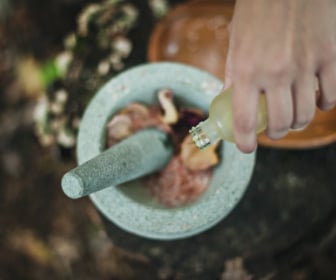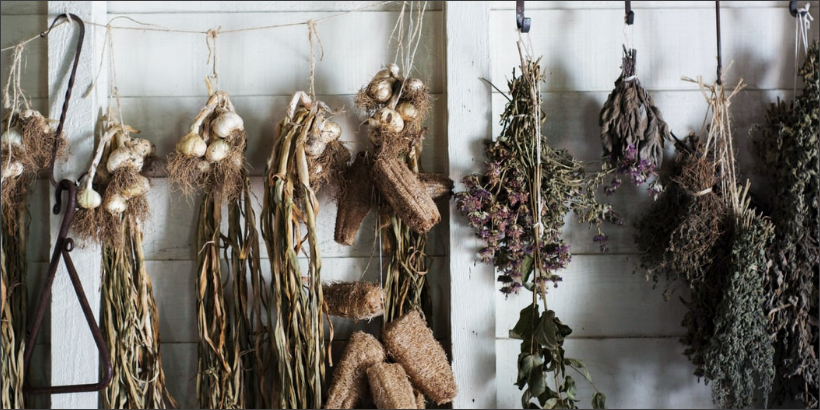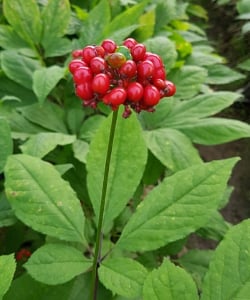Herbal Medicine: Knowledge Rooted in Connection
Using herbal medicine to heal the body is an ancient practice, but it has since become a worldwide industry in the twenty-first century. Today, modern-day doctor’s visits and industrial medicine have displaced common knowledge of herbal medicine. Some still remember the ancient practice, though. In her new book The Business of Botanicals, Ann Albrecht interviews one such person, Phyllis Light, a fourth-generation practitioner of what she calls Southern Folk Medicine.
The following is an excerpt from The Business of Botanicals by Ann Armbrecht and has been adapted for the web.
Realizing that we needed to diversify the voices we were recording for Numen, we headed to Arab, Alabama, to interview Phyllis Light, a fourth-generation practitioner of what she calls Southern Folk Medicine. Our conversations with Phyllis brought in the perspective of the practice of herbalism passed through family in a tradition that was never broken.
Phyllis is more rooted in the physical and cultural place of her home than anyone else I have met in the North American herb community. She still lives in Arab, the town where her ancestors lived and where what she calls the mishmash of cultures that make up her heritage came together. Phyllis’s entire family—on both sides—was involved in folk healing, a mix of Native American knowledge about plants and the spiritual knowledge of African slaves who had been brought to North America by the Spanish. Europeans added their system based on the ancient Greek humoral methods made popular by Galen. The Scots-Irish, who came to the area in the 1700s and 1800s, brought in a superstitious or magical framework that they combined with what they found in the Bible and Christianity.1 “So we have about a four-hundred-year history of folk medicine in the South. Other parts of the country can’t say that,” Phyllis told me with pride.
The Civil War helped solidify herbal use in the South, she continued. “I’m not going to get into the politics of it. We all know slavery was not a good thing.” But the South was blockaded by land and by sea and so certain foods and medicine weren’t available. Southerners had to go back to using herbs as medicine, she explained, adding that some of the best herbal books were written during the Civil War.
After the Civil War, the land was ruined: “The barns and houses had been burned. The fields and crops and soil had been burned. The land was in waste and devastation. The slaves were free, but they had nowhere to go. Reconstruction was a really horrible time. Then, too, herbs were the only thing people had as medicine.”
“Every woman had to know to care for her children and her family using herbs, because that was all there was.”
“No one could afford to go to the doctor, and there weren’t many doctors even if they could.”
Just as the South’s economy was beginning to stabilize, the Depression hit. Phyllis recalled that her grandfather used to say, “I read in the paper that there is a Depression, but we couldn’t tell any difference in our family.”
When Phyllis was ten years old, she began gathering herbs with her grandmother, who was part Creek and part Cherokee and had been taught by her own mother and grandmother. Phyllis’s father took over after her grandmother died. “On my dad’s side, I’m part Native American, German, and Jewish German. I’m a little Oriental and definitely Scots-Irish,” Phyllis explained.
 Phyllis has thin, straight blond hair, cut just below her ears, that ripples as she shakes her head to emphasize her points. In a photo taken when she was seventeen, Phyllis’s set jaw shows her determination—like the shake of her head, her expression seems to say, Don’t even think of crossing me. Sitting at the linoleum table in her kitchen that she uses for teaching, Phyllis described growing up in Arab at a time when everyone lived off the land because that’s all they had. “We all had gardens. We all raised our own animals for food. We all farmed and hunted and went to the woods to gather wild food and herbs. That’s just the way life was in that part of the South. Drop me in the woods with a knife and I’ll make it. I know how to eat, how to make a shelter, I know what foods to eat. I know what herbs I’m gonna need for medicine.
Phyllis has thin, straight blond hair, cut just below her ears, that ripples as she shakes her head to emphasize her points. In a photo taken when she was seventeen, Phyllis’s set jaw shows her determination—like the shake of her head, her expression seems to say, Don’t even think of crossing me. Sitting at the linoleum table in her kitchen that she uses for teaching, Phyllis described growing up in Arab at a time when everyone lived off the land because that’s all they had. “We all had gardens. We all raised our own animals for food. We all farmed and hunted and went to the woods to gather wild food and herbs. That’s just the way life was in that part of the South. Drop me in the woods with a knife and I’ll make it. I know how to eat, how to make a shelter, I know what foods to eat. I know what herbs I’m gonna need for medicine.
“When I heard people talking about the herbal renaissance, I was like, What in the world are they talking about? We didn’t need any renaissance because we already had it. We didn’t know we were holistic,” she added. “We were just poor.”
I asked Phyllis about her relationship with plants. She answered by telling me a story.
One morning when she was seventeen, her father told her they were going to the forest to find ginseng. It wasn’t the season for digging ginseng, she said, they were simply venturing out to locate some plants. By that time Phyllis had spent plenty of seasons with her family “sanging,” as hunting ginseng is called, but she had never tried to find a ginseng plant without the red berries that are its signature. She and her father walked and walked. Finally, after what seemed a long time, he stopped and told her that “between that creek, them rocks, and that tree, there’s some ginseng plants, and I want you to find them.” And then he pulled out his paperback western from his back pocket, sat down, and began to read.
 “There I was standing in the middle of all these plants that all hit around my knees, and they all looked exactly the same. They were all green, and they all had leaves,” Phyllis said.
“There I was standing in the middle of all these plants that all hit around my knees, and they all looked exactly the same. They were all green, and they all had leaves,” Phyllis said.
She looked and looked. She couldn’t see any ginseng. She asked her father for some help, but he ignored her and continued reading his western.
She kept looking. Eventually her father told her, “You better hurry up, we have to get home for supper.”
“And I am so frustrated that I’m starting to cry,” Phyllis told me, her voice inflected with the accent of her home. “I’m getting mad at myself, and I just stopped and took a breath. Right in the middle of all this green stuff, I just paused. And suddenly I didn’t care anymore if I found those ginseng plants or not. I was done. I closed my eyes. I could hear the birds, and I could hear my daddy turning the page in the book, and I could hear the creek bubbling over the rocks, and I could hear the wind flowing through the trees, and in that instant I really couldn’t tell the difference between myself and the wind, and myself and the creek, and myself and the pages of that book. And when I opened my eyes I saw seven ginseng plants, outlined in light. It was the most amazing experience of my plant life.
“And I looked at my daddy and I said, ‘Here’s one, here’s one, here’s one!’ I was so excited! And he stood up, and he said, ‘Yep. Let’s go eat.’ He put his book in his back pocket and started walking toward home.
“And that was my teaching. That’s how my dad always taught me. That’s how my grandmother taught me. They taught me by making me learn. They didn’t teach me with a lot of words. Those were the teachings I had all through my early years of herbalism: How do you connect? How do you see what isn’t there?”
The herbal medicine Phyllis learned came from her relationship to a particular place, to the plants that grew there, and to the people who knew those plants and how to use them, steeped in knowledge that had been passed down to them from their mother or father or grandmother. It wasn’t a product separate from the source.
It was knowledge rooted in connection.
Notes
- Phyllis Light, Southern Folk Medicine: Healing Traditions from the Appalachian Fields and Forests (Berkeley, CA: North Atlantic Books, 2018).
